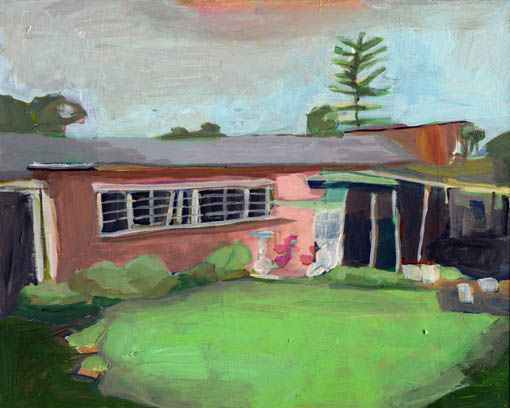Landmarks
Sue Michael, Flamingo Front Yard, Broadview, 2016, acrylic on board, 20 x 25 cm
This house is on the other side of the big main road from me. it nestles in a street I do not often drive through but I am familiar with it. This house always has caught my attention with its plastic, pink flamingos that are sentinels at the front door. I believe they are no longer there. Distinctive or prominent aspects of place (a front yard in this case) can be markers that an artist can highlight. Dean Radin, from the Institute of Noetic Science, proposes that when we approach stories there are mostly explanations that are presented to us, but to lesser degrees there are also confabulations, made-up frauds, selective memories, as well as unexpected ideas that intuitively emerge as ‘something else from consciousness’.
Sue Michael, Flamingo House no.13, 1998, Type C photograph, Diana camera,
I have kept noticing this landmark architecture and so have a series of images that span decades. How have I, as an artist, potentiated the role of this modest ‘landmark’ home?
Looking at the painting of the same scene I still have provided a narrative description, and the mapping of this front yard. Semi -abstract painting also allows me to remove unnecessary visual information so that the viewer can potentially see the landmark more clearly. By placing emphasis on important components, the artist can pronounce a mood, and express the conditions of possibility. The green grass may suggest what holds people together in that place, a sense of domestic pride and ‘nourishment, in this case, with a respect shown to the people at the heart of that place, simply through the choice of the refreshing green.
Wider understandings of place can ripple out from these small representations, and viewers in other nations or globally, can begin to understand particular places through art. Because the artist has been motivated to record perhaps an overlooked aspect of place they therefore add to a collective register. This may counter dominate place stories, and help to elevate local landmarks that have been only highly valued by local dwellers. The artist can enhance the imagination of the viewer and share aspects of that place’s ‘energies’.
Of course there is a long tradition of artists providing privilege to their private aims over other public concerns, and the use of a plastic camera may be such an example . Flamingo House no 13, was made using a toy camera, and helps to create a diffuse and blurred image on film that conveys a dream-like quality. My aims as a Pictorialist photographer have over-ridden an concern for documenting the house ‘as is’. The late afternoon sun with its warm tones also add to the dream-like quality. These were purposeful decisions on my behalf to elevate this house as a landmark in comparison to others. It does require careful balance so that subjective representations do not over ride documentation though.
There is a suggestion that artists can step in to convey a sacredness that is felt rather than seen, and this is useful when words fail. The artist may be well suited to document the ‘clearly invisible’. If the artist is aware of this responsibility theycan infuse their expressions with this sort of pathos, again helping to make their object/theme/ persons of focus prominent. Art can provide entertainment, novelty and sensory contrast, but it also can provide instruction. Landmarks can be catalysts, where one decision points to another. The artist would do well to learn to select, to combine, and to modify the rich natural diversity of the world around us.
What are the substantive contributions to an understanding of this home owner’s place in the world? What development with various materials can I use to explore how to elevate a landmark? How can I avoid a commitment to generalisation? I need to see the proof of my interrogation of a place in my art experiments.
Further reading:
Edmunds V. Bunkse, Humboldt and an Aesthetic Tradition in Geography, Geographical review, Vol. 71, No2. 1981.
Dean Radin, Real Magic: ancient wisdom, modern ccience, and a guide to the secret power of the universe, Harmony Books, 2018.

